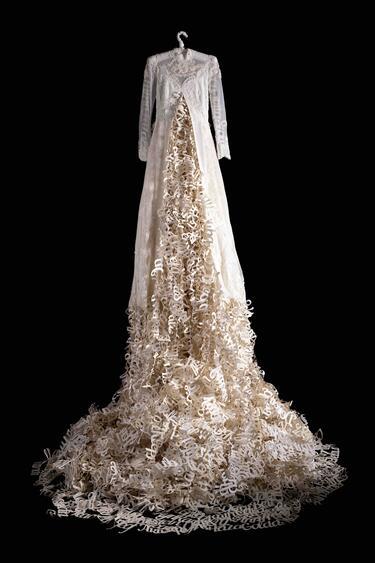Q & A with Artist Andi Arnovitz about her new piece, "What We Bring"
JWA talks to Israeli artist Andi Arnovitz about her new (JWA-inspired!) piece, What We Bring, currently on display at the Jerusalem Biennale.
This interview has been edited for clarity.
JWA: Tell us what inspired the creation of this piece.
Andi Arnovitz: I’ve participated in every Jerusalem Biennale since its beginning in 2013. Every Biennale, they assign a theme. The theme for this one is “Tzon Barzel," meaning "Iron Flock." The term is found in the Mishnah. It represents a category of assets that is defined by specific terms concerning two parties. It is mainly used in the context of marriage agreements. A woman can bring assets with her into a marriage, which will remain hers, regardless of the fate of the marriage.
In modern Hebrew, the term “iron flock assets” (nichsei tzon barzel, נכסי צאן ברזל) has become an idiom expressing a notion of spiritual assets and an inalienable cultural legacy. The theme of Iron Flock aimed to inspire curators, artists, and creators to explore the foundations of current culture and the ways they are present in contemporary artwork.
I wasn’t going to participate this year, as I found the theme hard to get my head around. But then, in cleaning out a bedroom in our house, I found my wedding dress in a box and wondered what in the world to do with it. I had also, at the same time, been doing a deep dive into the Jewish Women’s Archive, and I especially loved the encyclopedia. I suddenly had this idea to connect the two things: to use all the names in the encyclopedia, and have them come pouring out of this wedding dress.
JWA: Can you describe the process of creating this work? It must have taken a long time and incredible patience!
AA: So first I took the wedding dress to a tailor and asked them to split it up the middle. They looked at me like I had two heads, but they did it. Then I sat and for several days typed in all 2,611 names of women (not institutions) in the JWA Encyclopedia! Then I went to my beloved fine art printer and magician Yair Medina, and we worked out how we could laser cut these names. We had to find a cursive typeface that would link one letter to the next and still make it readable. Then we experimented with many different fabrics: cotton, canvas, even felt, trying to find one that was fluid but also strong, and we ended up using simple bookbinding cloth.
So after manipulating the typeface a bit, all the names—all 2,611—were laser-cut, and then I had the task of sewing them into the wedding dress. I probably had my head inside that dress sewing for many weeks. But I discovered that the installation would be simpler, as I could sew many names inside, but then make piles of the names underneath, without actually sewing them. Once I had about 200 names sewn inside, I could see the piece was going to work the way I had envisioned it.
JWA: Why did you choose to use your own wedding dress for this piece?
AA: All my kids are married and none of them wore it anyway! (I was tiny then…) I’m a big recycler and re-purposer. I’ve made several museum pieces out of all the etching proofs that pile up in my studio from printmaking (called UnWearable Art). There was no way I was going to throw this dress away or even give it away. My grandmother hand-sewed the pearls on the bodice. My father had a fabric store when I was growing up, and the lace was Alencon lace from France. So this suddenly gave me a way to keep my dress, but repurpose it.
JWA: The piece is called “What We Bring.” Can you explain the meaning behind the name?
AA: In terms of the theme of the Biennale, this piece emphasizes that we women, Jewish women, make up half the marriage between God and the Jewish people. And these women symbolize all the things Jewish women have brought to humankind. A woman brings all sorts of assets to her marriage—not just material things, but her brains, her creativity, her insights, and her vision. JWA’s website says: “The Jewish Women’s Archive documents Jewish women’s stories, elevates their voices, and inspires them to be agents of change.” All the women in this piece were and are agents of change. This is what we bring to the world.
The list begins with Eve in the Bible and continues through to feature figures like Ruth Bader Ginsberg and Gal Gadot. Among them there are poets, actors, philosophers, politicians, scholars, teachers, doctors, artists, and nuclear physicists. All these Jewish women have impacted and even altered history.
My piece can be read multiple ways. It’s a literal interpretation of what we women brought (and bring) to half of “our” marriage between God and the Jewish people. But it’s also a graphic illustration of what Jewish women bring and build as cultural assets to history and humankind. The wedding dress is bursting with names—these amazing women pour out of the wedding dress, spill onto the floor, and out into the room. The mere act of marriage cannot contain us. The concept of “bride” is too limiting—it cannot hold all that we bring.
JWA: How has the ongoing war in Gaza affected the Jerusalem Biennale? How has it affected you as an Israeli artist?
[After October 7], the Biennale was immediately postponed. It was supposed to be right at the beginning of November. They managed to reschedule it, but with much less funding. I have had many international shows canceled. I think Israelis right now are feeling marginalized and ostracized, like we are cultural outcasts. In fact, the world of culture today is perhaps one of the worst in terms of canceling others. There was a massive movement to prevent Israel from participating in the Venice Biennale this year. [Israel’s participation in] the Eurovision singing competition has been touch-and-go. A venue that holds London's biggest Eurovision screening party has canceled the event because of Israel’s participation. I think all of this is one huge pity. Culture is one the safest and most human places to both explore and listen to others. When music, art, dance, and literature excludes and shuts out voices, we all lose.
JWA: Are there any plans for exhibiting this piece after the Biennale? Will those of us outside Israel have a chance to see “What We Bring” in person?
AA: I don’t know yet. Pieces take a long time to make it out into the public. I’m always amazed when I make something—it might sit two to five years in the studio, and then suddenly, it’s in demand for exhibitions. Artists tend to respond to events in real time, and museums, just by virtue of being big institutions, tend to take a long time to present an exhibition to the public. I hope this piece gets to the US. It’s a big statement. It’s not at the expense of anyone, just a giant gesture of embracing and celebrating these incredible Jewish women.
I’m now working on a big piece with funding from the Memorial Foundation for Jewish Culture. This, too, will be a woman’s garment that will specifically address the “sheroes” in this war—the brave and strong women who have shouldered so much.









